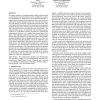Free Online Productivity Tools
i2Speak
i2Symbol
i2OCR
iTex2Img
iWeb2Print
iWeb2Shot
i2Type
iPdf2Split
iPdf2Merge
i2Bopomofo
i2Arabic
i2Style
i2Image
i2PDF
iLatex2Rtf
Sci2ools
HAPTICS
2009
IEEE
2009
IEEE
Remote dynamic proxies for wave-based peer-to-peer haptic interaction
This paper introduces a distributed haptic control architecture that can render direct interaction between users in addition to cooperative manipulation of virtual objects. The proposed architecture integrates remote dynamic proxies and peer-to-peer wave-based communications. Remote dynamic proxies are avatars of users at peer sites with motion governed by second order dynamics laws. They render physically-based motion of the distant users in the presence of update discontinuities caused by packet transmission limitations. They also enable users to touch their far away peers directly. The remote dynamic proxies are integrated with wave-based communications via a simplified symmetric algorithm for computing the transformation between wave variables and standard power variables. This algorithm implements peer-to-peer communications through input and output waves rather than master-slave communications through forward moving and returning waves. Wave variable controllers using this algo...
HAPTICS 2009 | Remote Dynamic Proxies | Virtual Reality | Wave Variable | Wave-based Communications |
| Added | 21 May 2010 |
| Updated | 21 May 2010 |
| Type | Conference |
| Year | 2009 |
| Where | HAPTICS |
| Authors | Zhi Li, Daniela Constantinescu |
Comments (0)

